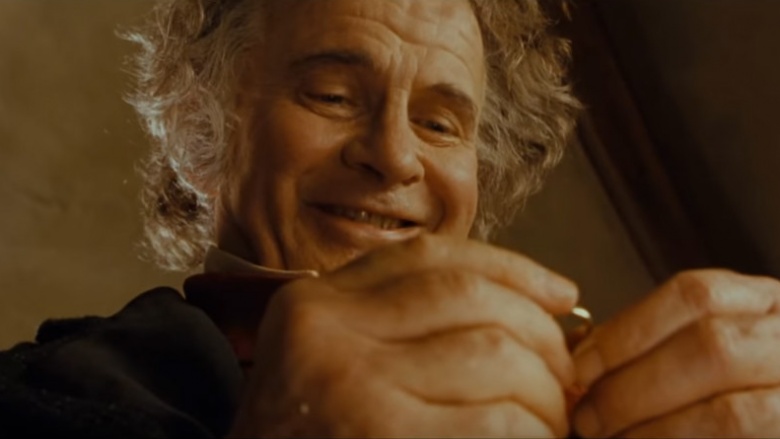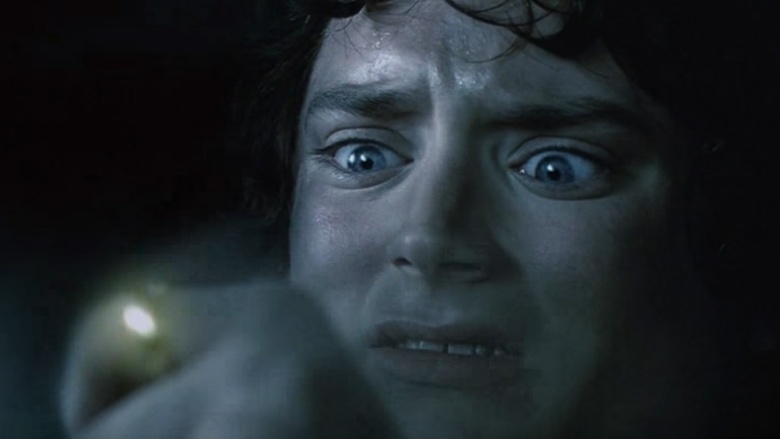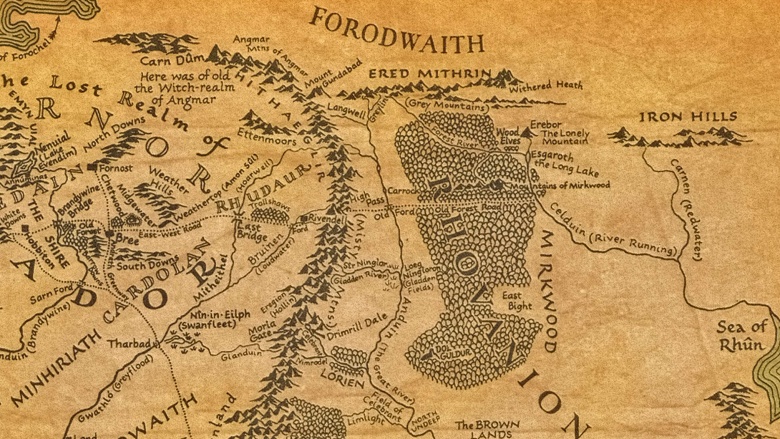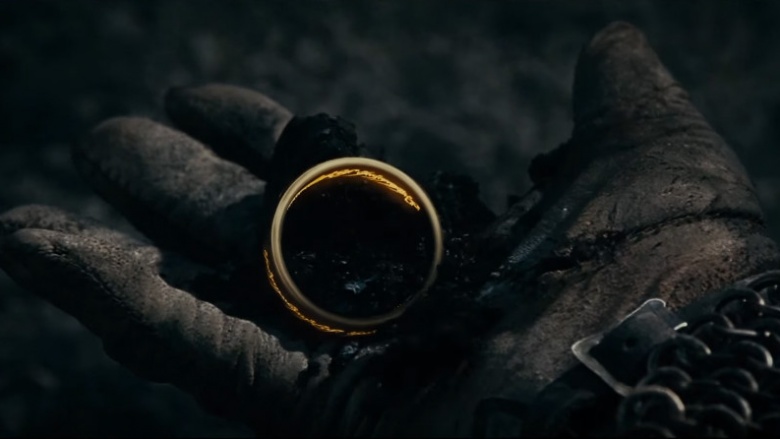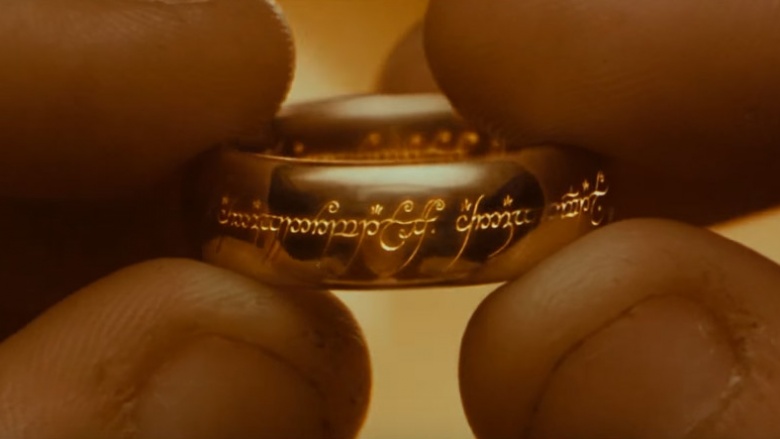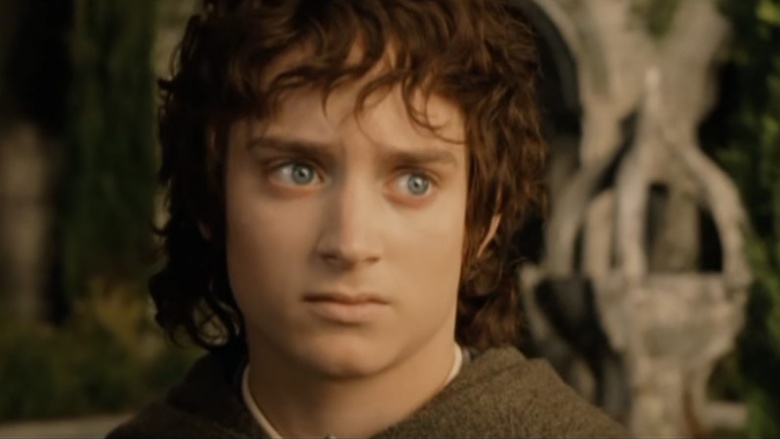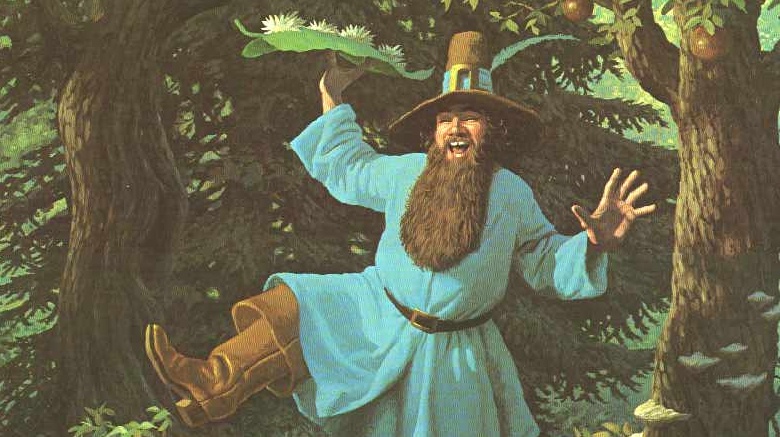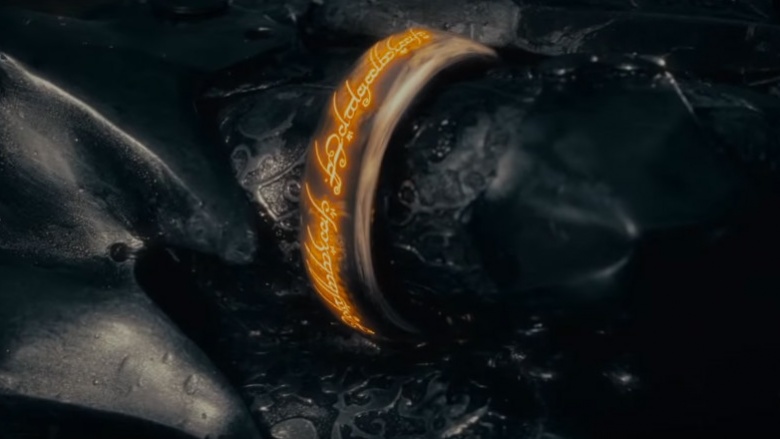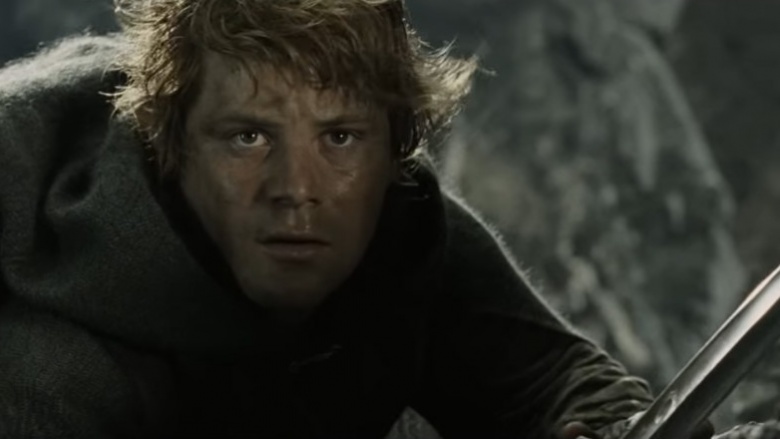9 Things You Didn't Know About The Ring In Lord Of The Rings
Epic battles, crazy special effects, drama, intrigue, bromance: the Lord of the Rings trilogy has it all. And binding all that magic together is the One Ring. Powerful and mysterious, the ring is always present, but never fully explained — even in the books, J.R.R. Tolkien never flat out revealed all the ring's powers and history. But between the films, the books, The Silmarillion, and Tolkien's own letters, we've been able to shine some light on this cursed object of darkness.
Aging is complicated
One of the virtues of the ring is the fact that when you have it, you stop aging. Bilbo still looked young at his 111th birthday, and Gollum had the ring for something like 500 years without any noticeable aging. All the changes that did come over him were mostly from living in a cave for all those years. Bilbo, of course, gave the ring to Frodo at the beginning of the trilogy, and by the end, Bilbo's youthful vigor had faded, leaving him an old, feeble hobbit — right about the age he should have been if he'd never found the ring in the first place.
Or did it? One of the details glossed over in the movies is that Frodo didn't even leave the Shire until 17 years after Bilbo's 111th birthday party. But when Frodo and the gang got to Rivendell, Bilbo still looked pretty much like Bilbo, not the half-hobbit shell you'd expect from a near-130-year-old halfling. It wasn't until the ring was destroyed that Bilbo's age progressed so rapidly. In other words, some of the powers of the ring stick with someone even after they lose the ring (or give it up, like Bilbo), although it's never explained exactly how long those trace effects last. If the ring hadn't been destroyed, would Bilbo have continued to live on like Gollum did?
Ring-wearers aren't just invisible
Most people watched Bilbo put on the ring at his birthday party in The Fellowship of the Ring and thought, "Cool, an invisibility ring." Obviously, there's a lot more to it than that, but the gist of the invisibility seemed to be pretty straightforward: put it on and disappear. Unless the Ringwraiths are around or Sauron's big fire eye is looking at you, you can sneak around unseen. But one thing we never got to see is the fact that the invisibility power wouldn't work for everyone. For example, Gandalf.
See, the ring doesn't technically turn its wearer invisible — it shifts the wearer's body into another realm. That's why the world goes all shadowy from Frodo's point of view when he puts the ring on. It's also why Sauron isn't invisible when he wears the ring at the beginning of Fellowship (when Isildur chops his finger off). Sauron is part of a class of beings known as Maiar, spirits created by the god-like Iluvatar to help him deal with the little details of the world. They're kind of like angels. So since he already partly exists in the spirit world, Sauron doesn't travel there when he slips on the ring. Like Sauron, Gandalf is also a Maia. Gandalf is too wise and wizardly to risk wearing the ring, but if he ever did, and pretending for a second that this is Middle-earth High, he'd still need another way to slip into the girls' locker room. Of course, he'd still find a way. The guy's a wizard.
The ring drove Gollum to the Misty Mountains
At the beginning of The Return of the King, we see how Gollum first came across the ring. Then known as Smeagol, he's out fishing with his cousin, Deagol, when Deagol finds the ring at the bottom of the river. Smeagol kills his cousin, steals the ring, calls it beautiful or something, and then hotfoots it to the Misty Mountains, where he lives for the next five centuries. But why the Misty Mountains, where he was obviously in danger of being discovered by the goblins who also lived under the mountains?
The answer: the ring led him there. The Misty Mountains, the central mountain range on the map above, lie near the border of Mirkwood (the forest with the giant spiders in The Hobbit). Mirkwood is where Sauron's spirit was regaining its strength during the events preceding, and partly during, The Hobbit. In The Fellowship of the Ring, Gandalf says, "The Ring was trying to get back to its master. It had slipped from Isildur's hand and betrayed him; then when a chance came it caught poor Deagol, and he was murdered; and after that Gollum, and it had abandoned him ... so now, when its master was awake once more and sending out his dark thoughts from Mirkwood, it abandoned Gollum."
Basically, the ring led Gollum to the mountains so it would be closer to Sauron until it was time for the ring to continue its journey to its master. That's also why...
The ring can change size at will
"A Ring of Power looks after itself, Frodo," says Gandalf in The Fellowship. Just like the ring led Gollum closer to Sauron, it can also decide when it's time to get lost — literally. We saw the ring shrink down to the size of Isildur's finger at the beginning of The Fellowship movie. But then, when Isildur was attacked by orcs, he put the ring on his finger and tried to escape across the river. That's when the ring decided to change size and rid itself of Isildur until someone else found it ... someone who would do a better job of bringing it to its master.
The scene where Isildur loses the ring was filmed, but it was only released on the Extended Edition DVD, so a lot of people missed the significance of the ring changing size. While it was widely assumed that the ring simply took on the size of its new owner's finger, the truth is that the ring chooses when it wants to transform. It's been argued for years whether the ring is actually sentient — and the debate has never been resolved — but the general consensus is that it's basically been magically "programmed" to take the quickest route back to Sauron, whatever that may be. Frodo never lost it because he carried it on a chain most of the time ... and because he was carrying it straight back to Mordor.
The ring's inscription isn't Elvish
The flaming letters on the one ring look awesome, but even more exciting, they're contextually and historically significant. Hooray! In English, the inscription reads "One Ring to rule them all, One Ring to find them, One Ring to bring them all and in the darkness bind them." In the writing on the ring, however, this phrase is inscribed in Black Speech, a language created by Sauron that uses Elvish lettering in a corrupted form.
But more importantly, the ring represents the only written form of pure Black Speech that Tolkien ever created. When Sauron comes back in the books, he tries to make Black Speech the official language of Mordor, but the orcs keep messing it up like doofs and create their own bastardized version of the language to use among themselves. Because of that, orcs in the books never speak the pure form, so the only time that form appears is on the ring itself. Tolkien himself hated the language, which may be why he never expanded on it the way he did with Elvish. In one of his letters, he even said that he loathed a cup that one of his fans sent him because it was "engraved with the terrible words seen on the Ring." He added, "I of course have never drunk from it, but use it for tobacco ash." He used it for an ashtray. Nice.
It grants passage into the Undying Lands
By the end of the Lord of the Rings trilogy, there were seven people who had ever carried the one ring: Frodo, Bilbo, Sam, Gollum, Deagol, Sauron, and Isildur (well, eight if you count Tom Bombadil). Deagol, Sauron, and Gollum died during the story, and Isildur was dead a long time before any of it started. And at the very end, the ring gave the three remaining ring-bearers access to the Undying Lands.
Not through its own powers, of course. But carrying the ring is a heavy burden, and nobody understands that better than the elves. As a reward to the ring-bearers who were still alive after the ring was destroyed — Bilbo, Frodo, and Sam — the elves allowed them to travel to the Undying Lands. Besides Gimli (who went because he was Legolas' immortal bro), those three were the only mortals who were allowed to go to across the sea with the elves.
It reveals a lot about Tom Bombadil
For better or worse, Tom Bombadil never made it into the Lord of the Rings films. The free-spirited nature-dweller whom the hobbits meet after leaving the Shire is just as mysterious now as he was back when Tolkien first wrote the books. He comes into the story out of nowhere and then disappears just as suddenly, and that's led to a ton of fan theories about who he really is. Some people think he's the Witch-king, others think that he represents the readers of the book, but one of the most reasonable theories is that Bombadil is the embodiment of creation, a suggestion strengthened by the way he deals with the ring.
When Frodo and the 'bits run into Tom Bombadil, there's a scene where he takes the ring and tries it on: "Then Tom put the Ring around the end of his little finger and held it up to the candle-light. For a moment the hobbits noticed nothing strange about this. Then they gasped. There was no sign of Tom disappearing!"
After that, Tom gives the ring back to Frodo "with a smile" and Frodo waits for the right moment to put the ring on his own finger, just to make sure Bombadil didn't pull any ring-switching shenanigans. It works — he turns invisible — but as he tries to sneak away from the table, Bombadil calls him back and says "Old Tom Bombadil's not as blind as that yet." Based on the way Bombadil wasn't affected by the ring (and didn't try to keep it), it's obvious that Bombadil is above the influence of the ring. Later, Frodo asks Tom's wife, Goldberry, who Bombadil is. She says simply, "He is." Although she says it normally, the translation in Elvish is "Ea," which happens to be another name for the fires of creation that first made the world. And all that from one paragraph where Tom Bombadil holds the ring.
It can warp reality
One of the rarely seen powers of the ring is its ability to confuse whatever happens to be close to the guy carrying it. This happens a grand total of twice in the whole trilogy. In The Return of the King, Sam takes the ring after believing that Shelob killed Frodo. He continues on Frodo's quest, only to soon find himself trapped by orcs in Cirith Ungol, that tower in Mordor where the orcs took Frodo's body. In the film, Sam does some stair-stepping derring-do and whacks down a couple of orcs with Sting, but in the book he turns into a full-fledged nightmare the likes of which have only been seen by Scarecrow's victims in Batman Begins.
During the same scene in the book, Frodo goes into Cirith Ungol and comes across an orc. That's when this happens: "what it saw was not a small frightened hobbit trying to hold a steady sword: it saw a great silent shape, cloaked in a grey shadow, looming against the wavering light behind; in one hand it held a sword, the very light of which was a bitter pain, the other was clutched at its breast, but held concealed some nameless menace of power and doom. For a moment the orc crouched, and then with a hideous yelp of fear it turned and fled back as it had come."
Just by holding the ring, Sam gave off such a terrifying aura that orcs themselves turned tail and ran like scared puppies. The same thing happened again when Frodo was fighting Gollum in the Crack of Doom. Before Sam's eyes, Frodo turns into "a figure robed in white, but at its breast it held a wheel of fire." If the ring had only shown off those powers earlier, Frodo could have just walked straight into Mordor.
It proves that Sam is the real hero
It's obvious, really: Samwise Gamgee is the real hero of The Lord of the Rings. Tolkien thought this himself. In a letter he wrote to Milton Waldman, he called Sam "the chief hero" of the story. Damn, Frodo. That sucks. But it makes sense. You could say that without Sam, Frodo never would have made it all the way to Mordor. You could say that Sam ran interference for Frodo's bum rush to the end zone.
But it's not the end of the story. Every hero needs a sidekick, but doing a sidekick's job doesn't make the sidekick the hero. On the other hand, doing the hero's job ... well, that a hero of a sidekick makes. Remember how Sam picked up the ring after he thought Frodo was dead? In the film, he goes super-Saiyan-Sam (but still in a very Sam way) and brings the ring back to Frodo in Cirith Ungol. But in the books, Sam carries the ring for two whole days and is forced to wear it several times to keep from being seen by the orcs. Yet when he finds Frodo again, he gives it back immediately: "'All right, Mr. Frodo,' said Sam, rather startled. 'Here it is!'"
He just gave it up. Gandalf would barely touch it. Boromir was tempted to evil just by looking at it, but Sam carried the ring for days — after spending most of the trilogy right beside it, no less — and gave it back right away. If the ring's powers of corruption work in tune with a person's natural inclinations, then Sam must be as good as Sauron is evil. You go, Gamgee.

